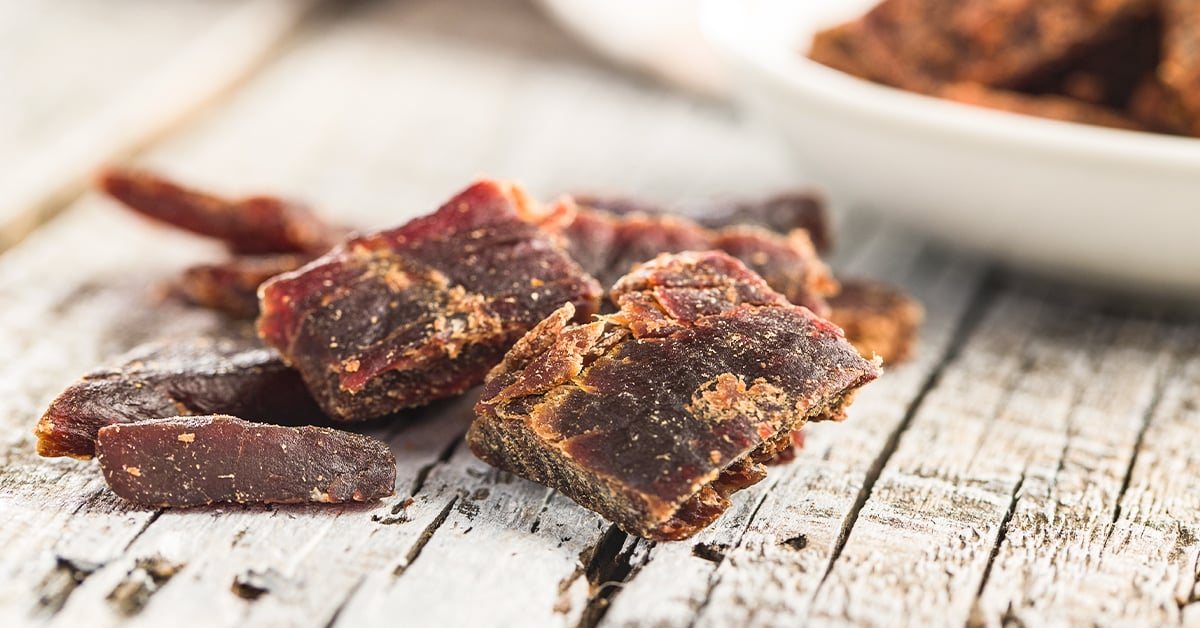
Hats off to the Roger Ball of Intermountain Bison, who mastered the technique of drying meat in his Salmon, Idaho, facility and then, according to his grandson Brigham, “revolutionized the jerky industry” with his production, packaging and distribution. Enjoy the Ball’s basic jerky recipe and use your favorite meat to try this age-old tradition.
Meat jerky is thought to have originated in South America during the 1800s. The Quechua tribe, who were ancestors of the ancient Inca empire, produced meat similar to modern-day beef jerky called charqui.
It was made by adding salt to strips of muscle tissue from game animals such as deer, buffalo, and elk, and allowing them to dry in the sun or over fires for extended periods of time. This method of preparation enabled the people to preserve meats during times when it was readily available and eat it when food was scarce.
When the Spanish encountered this method of meat preservation, they adopted it and made it available to the rest of the world. It became a staple foodstuff for American cowboys and pioneers. Early explorers built smoke huts and hung cuts of meat over a fire to smoke cure the meat. True jerky was made when the meat was first flavored and then cured. Over the years, people discovered that the meat could be made more palatable by the addition of various spices.
Ingredients
- Bison Sirloin Steaks - Sliced. You can use just about any cut of meat, but jerky works best out of lean meat.
- Worcestershire Sauce
- Soy Sauce
- Honey - 100 percent pure.
- Smoked Paprika
- Garlic Powder - Not garlic salt! Garlic powder.
- Onion Powder - Fresh onion, very finely minced will work here as well, but powder is easier. Try some of both.
- Hot Peppers - This could be cayenne pepper, chipotle peppers, red chili flakes, or any of the fresh peppers. You decide. Remember cooking will concentrate the flavors, so don’t get carried away.
- Spices - This is where your creativity comes in. You can try cumin, it goes well with Worcestershire sauce or fennel (the spice you would recognize from sausage links,) or just about anything else you like, salt and pepper. Kosher salt is nice because it’s chunkier. For peppered jerky, fresh, coarsely-ground black pepper is a must.
Directions
- In a large mixing bowl combine equal parts Worcestershire sauce and soy sauce as the base. A cup or so of each is a good place to start.
- Next, add some honey to taste. How much? Your nose will tell you when you have enough.
- Next, add spices. Mix well smelling the mixture as you stir it.
- After the marinade is prepared, add the meat and let it sit refrigerated overnight.
- In the morning, cover a baking sheet with aluminum foil and set a rack over the foil-lined pan. Stretch the meat out on the rack in an even and uniform way.
- Preheat the oven to 150 to 200 degrees (higher for thinner pieces and lower for thicker pieces) and place the pan in the oven for 3 to 4 hours.
- You’ll need to check the progress from time to time, which won’t be hard, because your entire house is going to smell absolutely heavenly. You want to dry the meat, but you don’t want it over-done. If the meat breaks like a cracker, you went too far. It should be slightly dryer than fruit leather, but not as dry as a cracker.
- When the meat is done, remove it from the oven and let it cool.
- Store your jerky in the freezer for up to 6 to 9 months if you package it right.
The recipe, story and photo are courtesy of the Ball family, owners of Intermountain Bison. To read more about their story, see Wrangling the Beast.









